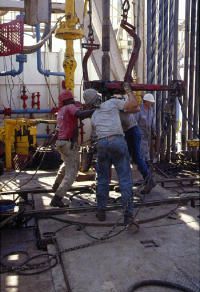The Oil Drilling Process
The crew sets up the rig and starts the drilling operations. First, from the starter hole, the team drills a surface hole down to a pre-set depth, which is somewhere above where they think the oil trap is located. There are five basic steps to drilling the surface hole:
- Place the drill bit, collar and drill pipe in the hole.
- Attach the kelly and turntable, and begin drilling.
- As drilling progresses, circulate mud through the pipe and out of the bit to float the rock cuttings out of the hole.
- Add new sections (joints) of drill pipes as the hole gets deeper.
- Remove (trip out) the drill pipe, collar and bit when the pre-set depth (anywhere from a few hundred to a couple-thousand feet) is reached.
Once they reach the pre-set depth, they must run and cement the casing -- place casing-pipe sections into the hole to prevent it from collapsing in on itself. The casing pipe has spacers around the outside to keep it centered in the hole.
Advertisement
The casing crew puts the casing pipe in the hole. The cement crew pumps cement down the casing pipe using a bottom plug, a cement slurry, a top plug and drill mud. The pressure from the drill mud causes the cement slurry to move through the casing and fill the space between the outside of the casing and the hole. Finally, the cement is allowed to harden and then tested for such properties as hardness, alignment and a proper seal.
In the next section we'll find out what happens once the drill bit reaches the final depth.
